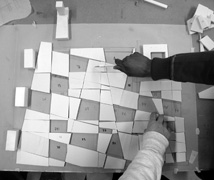|
BSc Unit E 2003-2004 Staff & Visitors
Jonathan Dawes Students
Sammy Adesoji
|
 Admixture Our research this year has focussed upon notions of mixing within Architecture. Centring our investigations on housing, we looked at how we might 'contaminate' our living environments with other uses. Our aims were to create a heterogeneous suburban situation where different ownerships might overlap and where spatial and material attitudes could become intertwined. Domestic Drifts In order to develop an understanding of the sequences of spaces that make up residential districts, individual and collective studies both in London and The Netherlands captured how these unfold. Between the individual dwelling and the public domain, routes mapped the park, garden, shop, nursery or workplace to define a locality by its constituent parts and their spatial and material hierarchies. Collective Intelligence Geuzenveld in the Western Garden Cities of Amsterdam became the suburban setting for intervention. The unit, operating as a collective, set about establishing strategies and spatial criteria within a shared site. A fragmented massing strategy evolved, where buildings and spaces in between were treated with equivalence. A group master plan documented a range of criteria as a rulebook and yielded a parcel for each individual to work on alone. Negotiating Territories Parcels bordered or overlapped several others and were loosely connected or clustered by different spaces: yards, alleys, greens, differing in scale and material, differentiating their hierarchy. These gaps became the armature from which individual building proposals were formed. Housing schemes of varying morphologies were developed, which combined a number of different users and ownerships. Critical Fragments Agendas were crystallised within fragments of building skins or landscaped elements, informed by the emergent orders of overlapped structural strategies, the continuity or grain of materials. Individuals demonstrated how to maintain transparency, inform porosity or pronounce hierarchy in their inhabitation of the collective built space. |